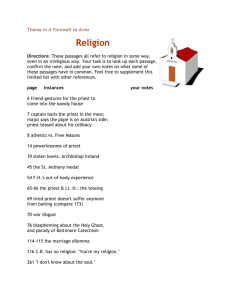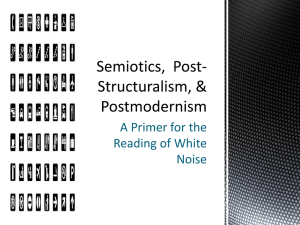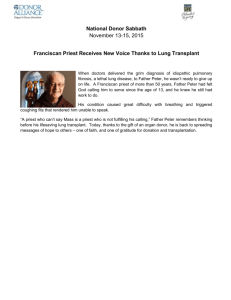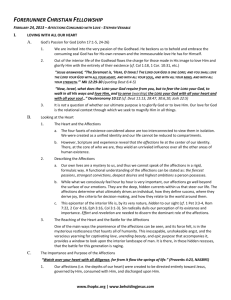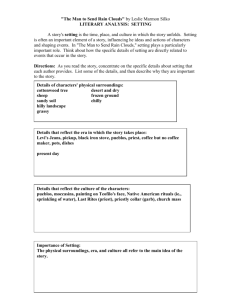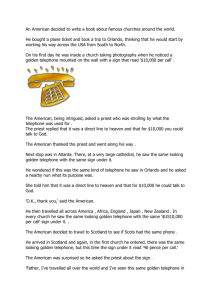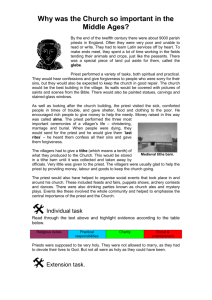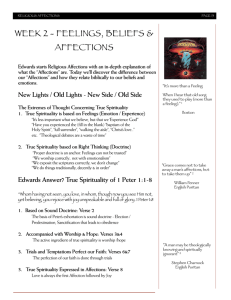A Swelling, A Rash, or a Discoloration
advertisement
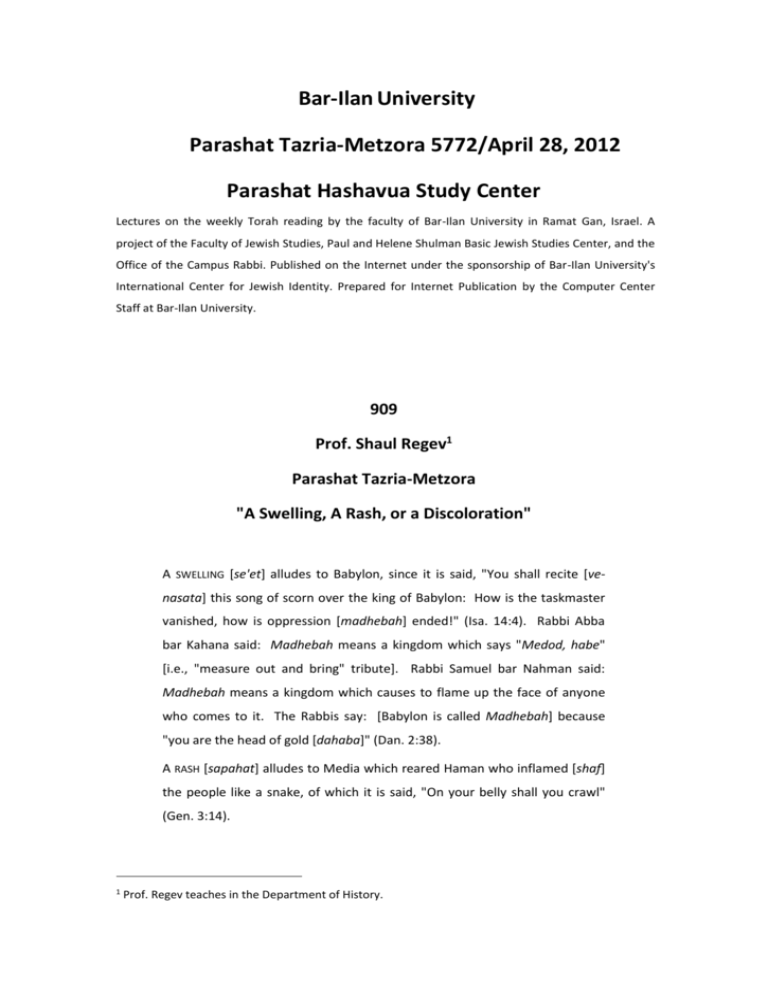
Bar-Ilan University Parashat Tazria-Metzora 5772/April 28, 2012 Parashat Hashavua Study Center Lectures on the weekly Torah reading by the faculty of Bar-Ilan University in Ramat Gan, Israel. A project of the Faculty of Jewish Studies, Paul and Helene Shulman Basic Jewish Studies Center, and the Office of the Campus Rabbi. Published on the Internet under the sponsorship of Bar-Ilan University's International Center for Jewish Identity. Prepared for Internet Publication by the Computer Center Staff at Bar-Ilan University. 909 Prof. Shaul Regev1 Parashat Tazria-Metzora "A Swelling, A Rash, or a Discoloration" A SWELLING [se'et] alludes to Babylon, since it is said, "You shall recite [venasata] this song of scorn over the king of Babylon: How is the taskmaster vanished, how is oppression [madhebah] ended!" (Isa. 14:4). Rabbi Abba bar Kahana said: Madhebah means a kingdom which says "Medod, habe" [i.e., "measure out and bring" tribute]. Rabbi Samuel bar Nahman said: Madhebah means a kingdom which causes to flame up the face of anyone who comes to it. The Rabbis say: [Babylon is called Madhebah] because "you are the head of gold [dahaba]" (Dan. 2:38). A RASH [sapahat] alludes to Media which reared Haman who inflamed [shaf] the people like a snake, of which it is said, "On your belly shall you crawl" (Gen. 3:14). 1 Prof. Regev teaches in the Department of History. A DISCOLORATION [baheret] alludes to Greece, who shone [mavheret] in her decrees against Israel, saying to them: "Write on the horns of an ox that you have no share in the G-d of Israel." A SCALY AFFECTION alludes to Edom [i.e. Rome] because it[s power] is derived from the strength of [the blessing of] the old man [viz. Isaac]. AND IT DEVELOPS INTO A SCALY AFFECTION ON THE SKIN OF HIS BODY (Lev. 13:2), since in this world the priest examines the affection, but in the World to Come, says the Holy One, blessed be He, "I will render you clean," as it is written (Ezek. 36:25): "I will sprinkle clean water upon you, and you shall be clean." (Leviticus Rabbah [Vilna ed.], Tazria, ch. 15.9) This week's reading deals primarily with the disease of leprosy, progressive stages in the development of the disease and methods of cure. The general idea is that these diseases concern impurity and therefore their cure is purification. Occasionally, when not dealing with a living body but with objects, the cure is achieved by getting rid of the affected item and replacing it with another. For example, if an eruptive affection appears on a house and all other measures prove to no avail, then the affected stones are removed and replaced by others. When the entire house is affected, then it must be totally destroyed and another built in its stead. In all instances the process of cure or rehabilitation depends on a single factor: not a doctor, but a priest, who assesses the severity of the affection and prescribes the actions necessary for curing it. The Torah ascribes great importance to these affections and devotes almost two entire weekly readings to them. In addition, we note that curing the disease or affection is not done by doctors and medicinal herbs, but by a priest. Both these things call for explanation. With regard to the cure being brought about by the priest, one might argue that he represented the educated strata of Israelite society, for the priests were the teachers and most likely had also learned the art of healing and served as healers, and therefore one would turn to them. But were this the case, the Torah's emphasis would be surprising; for it would be clear that one should turn to the appropriate expert for any problem that arises. The question remains unresolved as to why the Torah specifically mentions all the various forms of this disease or affection and their method of cure without mentioning a single treatment aside from isolation and purification. The three affections mentioned in the title (see Lev. 13:2) all have to do with leprosy, being its lighter manifestations, early signs of varying degree of severity that can develop into a raised, hard spot—a "scaly affection" or leprosy. Therefore, appropriate treatment at an early stage can prevent the condition from deteriorating. Various commentators, especially those whom we know also to have been doctors, have attempted to identify these affections in terms of what they knew from the medical books of their times and thereby also to understand the methods of cure. Most commentators, however, especially the homilists, provide no answer to the above-mentioned questions as to why the Torah mentions these affections and why the one who cures them is a priest and not a doctor. Perhaps this explains why they suggested viewing these affections as symbolic, be it on the general national level, or be it as an index of a person's degenerate religious behavior. It is as if Divine Providence sought to hint to human beings by means of these affections that they must change their ways, and therefore the solution lies in the hands of the priest, who also gives guidance and heals general behavior. In the midrash these affections are taken to symbolize the national condition in various periods of exile, in contrast to the state being cured, or redemption. Just as the affections are listed in order from the less serious to the more serious, so, too, the exiles of the Jewish people. We shall illustrate this by looking at Midrash Tanhuma (par. 11; also see the midrash quoted at the beginning of the article): Scripture is referring to the foreign nations that had hegemony over the Jews: "Se'et (a swelling)" refers to Babylonia, as it is written, "You shall recite this song of scorn [Heb. ve-nasa'ta] over the king of Babylon" (Is. 14:4). "Sapahat (a rash)" refers to the kingdom of Media, for Haman joined up with [Heb. me-sapeah] Ahasuerus to destroy, massacre and exterminate [the Jews]. "Baheret (a discoloration)" refers to Greece, which shone [Heb. mavheret] to Israel, saying, "Let whoever has an ox inscribe on its horns that they have no part in the G-d of Israel," and whoever did not do so would be sentenced to death. "And it develops into a scaly affection [Heb. tzara`at] on the skin of his body" (Lev. 12:2)—this refers to Edom [i.e., Rome]. Commentators chose to view all these affections as a single disease—leprosy—at different stages of development. Several sources in the Talmud and midrashic literature mention these affections as occurring on account of gossip (Arakhin 16b; Sifre Deuteronomy, Ki Tetze par. 275; and elsewhere), generally without detailing all the affections or mentioning their various stages. Later commentators and exegetes discerned a progressive development in these affections, stressing the particular symbolism of each one. R. Isaac Caro (16th century) drew a connection between the affections and the passages in the Torah that precede them, namely the prohibitions against certain foods in Parashat Shemini and the laws concerning a woman after childbirth (menstruation and circumcision) at the beginning of Parashat Tazria. In his view, these affections come in the wake of transgressions involving one or another of these proscriptions. Such transgressions are not generally visible to all, and therefore the affections appear and mark the person who has transgressed; then the community, realizing that the person affected must be guilty of transgressing one of these laws, draws away from such a person. Perhaps they distance themselves for medical reasons, nevertheless this response can also symbolize religiously distancing oneself, and therefore one turns specifically to a priest and not a doctor for cure. Rabbi Isaac was one of the few who explained this matter (Toledot Yitzhak, Lev. ch. 12): The passage, "When a person has on the skin of his body a swelling, a rash, or a discoloration" (Lev. 13:2), is juxtaposed to these three (forbidden foods, laws of menstruation and of circumcision) in order to indicate that if one takes care not to transgress in these three matters, then the affections discussed will not afflict such a person; but if one does not take care, then one will be affected. Insofar as most Jews take care in these three matters, there is not one in a hundred thousand Jews who is afflicted with leprosy, and a Jew who does have leprosy must surely have sinned regarding one of these three matters. Further, through this juxtaposition the Torah seeks to hint that since Jews are proscribed these three things, it is well known that all Jews are held to be kosher and careful in these three matters; that being so, if a Jew should chance to be afflicted by leprosy, surely it has come by Divine providence and therefore the person must repent. Hence, since Jews take care in these three matters, if a Jew nevertheless develops a swelling, rash, or discoloration on his skin the Torah prescribes that he should go not to a doctor but to a priest, and by his word he will either be cured and become pure or will be declared impure—not by the word of healers who address natural causes, but by healers who address matters of the divine, namely the priests. Special note should be paid to his remark about the small number of cases of leprosy among Jews. I do not know whether this was said as a general remark or a remark pertaining to his times. It is interesting that he remarks on the incidence of the disease among gentiles in comparison with its rare occurrence among Jews, since in the Middle Ages epidemics of plague generally broke out among the Jews later than among non-Jews, most likely because of the better hygienic practices among the Jewish population. According to Caro, this stemmed from observing these commandments, all of which have to do with health and hygiene. But, as we have said, these affections are an indication of sin and enable us to focus attention on the sinner and bring him back to the right way. In such a case the sick person will himself ask why this evil has come to him and will examine his deeds, knowing that the reason is not necessarily bodily, but rather related to improper behavior. Playing on the words used to name the various affections, Rabbi Tuviah ha-Levi (16th century, Tzfat) related them to human traits that lead a person to commit certain transgressions. These affections are listed in ascending order of severity, culminating with the most serious of all—leprosy, and a similar grading can be found in human behavior as well: from pride and the transgressions that come in its wake, through defacing that which has been sanctified to G-d and profaning the name of G-d, which is the most grievous transgression and the cause of leprosy (R. Tuviah ha-Levi, Hen Tov, Parashat Tazria): "When a person has on the skin of his body a swelling, a rash, or a discoloration"—these are categories of transgressions. A "swelling" pertains to pride, a swollen head and hence haughtiness (in general this also includes robbery and illicit sexual relations, for all these stem from pride)…These three are also subsumed in a "rash"…"Discoloration" comes when a person wishes to deface that which has been sanctified to G-d, and this is desecration of the Lord…as it is said, "When a person has on the skin of his body a swelling, a rash, or a discoloration," being the bodily manifestation of these transgressions…and from these transgressions leprosy can follow. A person who becomes afflicted by leprosy, the disease being on his skin and proceeding from his flesh outward—such a person can be cured by showing it to the priest; but leprosy which is rooted in the person himself cannot be cured by showing it to the priest. Rabbi Tuviah distinguishes between the early stages, during which the affection is manifest on the surface, on a person's skin. Such are relatively easy cases which can be cured by turning to the priest. But when the affection goes deeper and becomes leprosy, the priest can no longer help. At this point the sinner must resolve to mend his ways and change his religious behavior substantially. Therefore the cure is brought about by removal from the camp, so that in his solitary state the sinner can himself decide to take his future in hand. Carrying this notion further, we examine the words of Rabbi Mordechai ha-Cohen (16th century, Tzfat), who did not address the issue of the affections themselves, but rather of where they are situated. The affections are ordered from the external, easy case inwards to the harder flesh. Rabbi Mordechai ha-Cohen interpreted the words and the depictions as different stages of severity in the affection, symbolizing the degrees of severity of the sin. Each stage is supposed to rouse the affected sinner to repent, and when he does not do so, the next, more serious stage ensues. Having several stages before the onset of severe punishment is a result of the Creator having mercy on His creatures: He does not desire to punish them, rather prefers that they repent (Siftei Cohen): For the All Merciful does not directly exact His price, rather first He affects the skin, and then the flesh, entering into the flesh...and if he does not repent of his wrong deeds it enters the flesh which is under his clothes; and if still he does not repent, it enters his flesh which is exposed, and then it is called an affliction…and lastly leprosy. All this because of His great mercy towards His Creatures—first He strikes them in a place which is not seen, and if he does not repent, then He makes public [his misdeeds by] striking him openly, in a place visible to all. We conclude with the words of Rabbi Hayyim Joseph David Azulai (Hida, 18th century), who interpreted the entire passage as applying to sin, punishment and repentance. According to him, the sins include pride, anger and falsehood, and of course other sins that stem from these. Since these sins are in the realm of morality and are not quantifiable, so their punishment is out of the ordinary. According to Hida, not only the affections are symbolic, but also the priest, the spiritual leader of the times, is symbolic. His role is to persist in reproving the sinner and to bring him to repent, until finally the sinner does indeed return entirely to the right path (Homat Anakh, Parashat Tazria): When a person has on the skin, etc. The entire passage is to be interpreted in terms of transgression and the retribution received. A swelling refers to haughtiness, as it is written, "Every haughty person is an abomination to the Lord" (Prov. 16:5). A rash refers to anger, for it is an actionable sin as is idolatry. A discoloration refers to falsehood. And it develops into a scaly affection, meaning these are substantive transgressions. It shall be reported to Aaron the priest, that is to say, the matter shall be brought before the Sages. If hair in the affected patch has turned white, meaning if he remains rooted in sinful ways until he grows old and his hair turns white. When the priest sees it, he shall pronounce him unclean—since he persists a second and third time, repentance no longer can suffice. But if it is a white discoloration, meaning the sin has not tainted him so deeply. The priest shall isolate the affected person, reproving him in private. If the affection has remained unchanged, his reproof not having been to any avail, the priest shall isolate him for another seven days, reproving him again. The priest shall examine him again: if the affection has faded, his faced having blanched as he became contrite, and has not spread, and he ceases sinning, the priest shall pronounce him clean, outlining for him the path to repentance and pronouncing him clean.
